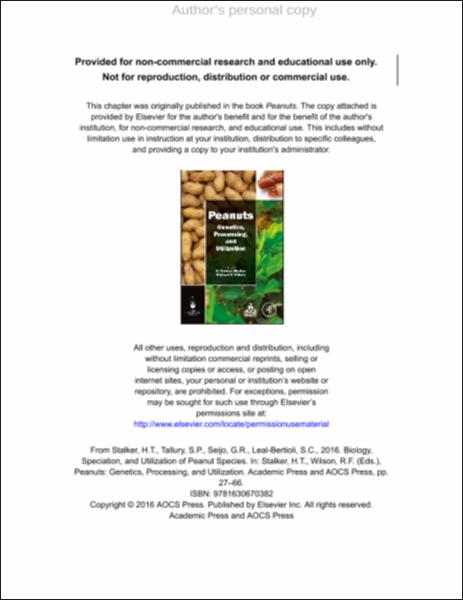Mostrar el registro sencillo del ítem
Biology, speciation, and utilization of peanut species
| dc.contributor | Stalker, H. Thomas | |
| dc.contributor | Wilson, Richard F. | |
| dc.contributor.author | Stalker, H. Thomas | |
| dc.contributor.author | Tallury, Shyamalrau P. | |
| dc.contributor.author | Seijo, Guillermo R. | |
| dc.contributor.author | Leal Bertioli, Soraya C. | |
| dc.date.accessioned | 2022-02-14T13:24:30Z | |
| dc.date.available | 2022-02-14T13:24:30Z | |
| dc.date.issued | 2016 | |
| dc.identifier.citation | Stalker, H. Thomas, et al., 2016. Biology, speciation, and utilization of peanut species. En: Stalker, H. Thomas y Wilson, Richard F., ed. Peanuts: genetics, processing, and utilization. Ámsterdam: Elsevier, p. 27-66. ISBN 9781630670382. | es |
| dc.identifier.isbn | 9781630670382 | es |
| dc.identifier.uri | http://repositorio.unne.edu.ar/handle/123456789/30849 | |
| dc.description.abstract | Peanut, also known as groundnut (Arachis hypogaea L.), is a native new world crop. Arachis species originated in South America and are found in tropical and subtropical areas. Eighty-one species have been named (Krapovickas and Gregory, 1994; Valls and Simpson, 2005; Valls et al., 2013), including the domesticated peanut, A. hypogaea L. Species have evolved in highly diverse habitats and both annual and perennial types exist. New species are being discovered in areas that previously were very difficult to reach because of poor roads and transportation. It is likely that the genus originated in the highlands in the southwestern Mato Grosso do Sul region of Brazil close to Gran Pantanal where the most ancient species of the genus (Arachis guaranitica Chodat. and Hassl. and Arachis tuberosa Bong. Ex Benth.) are found (Gregory et al., 1980; Simpson and Faries, 2001). Subsequently, as the planalto continued to be uplifted coupled with water flow, the genus spread into the drier lowlands of South America (Gregory and Gregory, 1979; Stalker and Simpson, 1995; Simpson et al., 2001). The genus likely originated in tropical wetland areas and subsequently adapted for survival in dry environments. | es |
| dc.format | application/pdf | es |
| dc.format.extent | p. 27-66 | es |
| dc.language.iso | eng | es |
| dc.publisher | Elsevier | es |
| dc.relation.uri | http://dx.doi.org/10.1016/B978-1-63067-038-2.00002-2 | es |
| dc.rights | restrictedAccess | es |
| dc.rights.uri | http://creativecommons.org/licenses/by-nc-nd/2.5/ar/ | es |
| dc.subject | Arachis | es |
| dc.subject | Center of origin | es |
| dc.subject | Disease resistance | es |
| dc.subject | Interspecific hybrids | es |
| dc.subject | Peanut | es |
| dc.subject | Speciation | es |
| dc.subject | Species | es |
| dc.title | Biology, speciation, and utilization of peanut species | es |
| dc.type | parte de libro | es |
| unne.affiliation | Fil: Stalker, H. Thomas. North Carolina State University. Department of Crop Science; Estados Unidos. | es |
| unne.affiliation | Fil: Tallury, Shyamalrau P. Clemson University. Pee Dee Research and Education Center; Estados Unidos. | es |
| unne.affiliation | Fil: Seijo, Guillermo R. Universidad Nacional del Nordeste. Facultad de Ciencias Exactas y Naturales y Agrimensura; Argentina. | es |
| unne.affiliation | Fil: Leal Bertioli, Soraya C. Embrapa Genetic Resources and Biotechnology; Brasil. | es |
| unne.book.city | Ámsterdam | es |
| unne.book.title | Peanuts : genetics, processing, and utilization | es |
Ficheros en el ítem
Este ítem aparece en la(s) siguiente(s) colección(ones)
-
Partes de libros [31]





